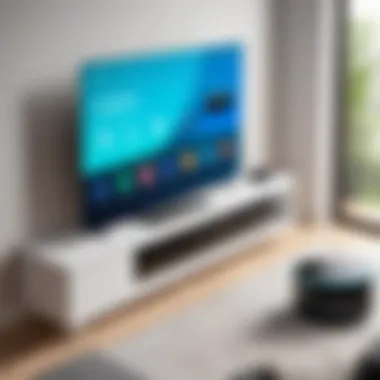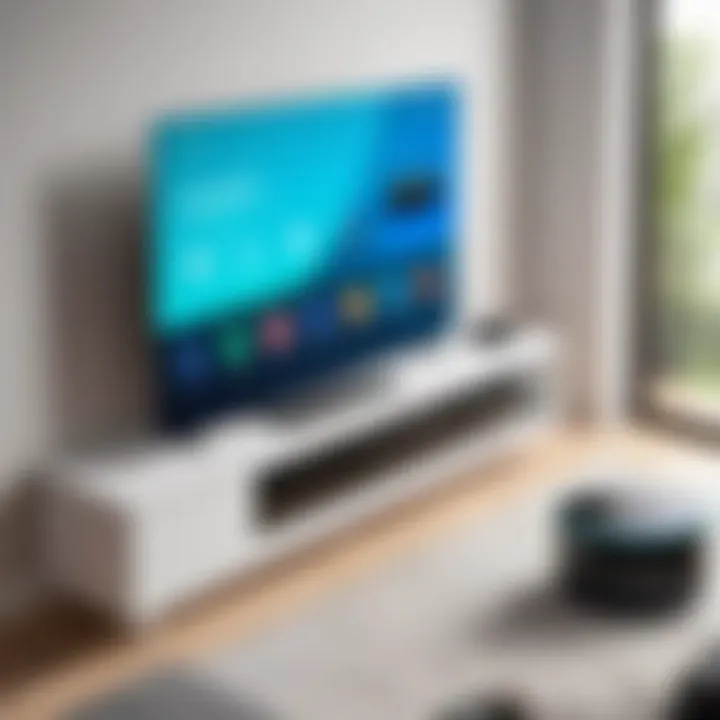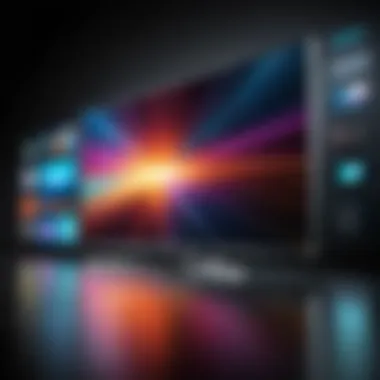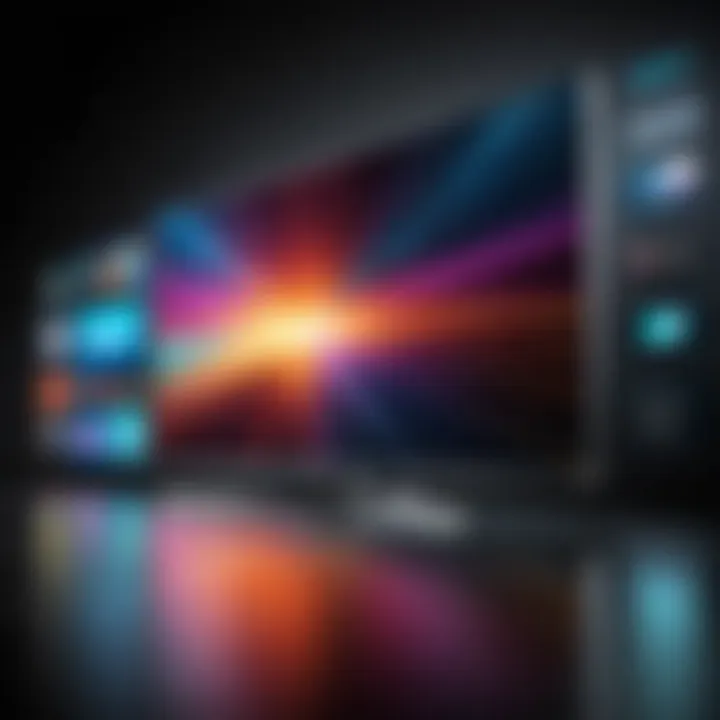Comparative Analysis of Leading Smart TV Platforms


Intro
Smart TVs have become the centerpiece of modern entertainment, merging traditional viewing pleasures with the latest technology. As consumers seek devices that not only display content but also integrate seamlessly into their daily lives, the variety of smart TV platforms presents both opportunities and challenges. The choice of a smart TV platform can significantly affect user experience, access to content, and compatibility with other devices.
With platforms like Android TV, webOS, Tizen, and Roku stepping into the limelight, understanding their unique offerings becomes crucial. This comparative analysis aims to shed light on how each platform stands out in terms of features, performance, and ecosystem integration.
Features Overview
In the realm of smart TVs, features play a pivotal role in determining a platform's utility and popularity. Users often delve into the minutiae of specifications to find what suits them best.
Key Specifications
When we examine the key specifications across various smart TV platforms, several elements come into play.
- Android TV: Known for its comprehensive app ecosystem supported by the Google Play Store. Features voice search powered by Google Assistant, and tight integration with smart home devices.
- webOS: It stands out with its minimalist interface, called the "Launcher," allowing easy access to apps and features.
- Tizen: This platform is recognized for its vibrant design and is heavily integrated into Samsung's broader ecosystem.
- Roku: Offers a user-friendly interface with access to a myriad of channels and content. Its unique algorithm curates personalized content recommendations.
Unique Selling Points
Each platform brings something distinct to the table:
- Android TV: Flexibility and customization options with a broad app catalog.
- webOS: Seamless user experience with its intuitive design and navigation.
- Tizen: Strong emphasis on performance and integration with Samsung devices.
- Roku: Excellent for those looking for a simple setup with vast content availability.
Prologue to Smart TV Technology
Smart TV technology represents a significant transformation in how we consume media. In this era, where entertainment options are virtually limitless, the integration of internet capabilities into television sets has become a game-changer. The immediate access to streaming services, social media, and even gaming applications has redefined the living room experience. Thus, exploring the various smart TV platforms is essential, especially for tech enthusiasts and IT professionals looking to stay ahead in this rapidly progressing field.
Definition and Origin
A smart TV can be defined simply as a television that is connected to the internet and equipped with a user-friendly interface allowing for interactive features. These devices typically come with pre-installed apps like Netflix and YouTube, enabling users to stream content directly from the internet. The origin of smart TVs can be traced back to the early 2000s when manufacturers first added internet connectivity and search capabilities to traditional TVs. Over the years, this concept burgeoned, leading to the sophisticated systems we see today. The rise of platforms like Android TV and Roku illustrates this evolution, where manufacturers have created ecosystems around their smart TV offerings, allowing third-party developers to contribute applications that enhance the user experience.
Importance in Modern Entertainment
In the current digital age, smart TVs have cemented their place in households globally. They allow users not only to watch regular broadcasts but also to access a wide array of content options. The convenience of having streaming services right at one's fingertips has shifted viewer habits and expectations.
Moreover, the importance of smart TV platforms extends beyond just content consumption:
- Centralization of Media Consumption: With smart TVs, different types of media can be accessed from one location, reducing the need for multiple devices.
- Enhanced User Interaction: Many platforms feature intuitive interfaces that facilitate easy navigation, further enhancing user engagement.
- Compatibility with Other Devices: Smart TVs are often part of a broader ecosystem, integrating seamlessly with smart home devices, thus making it easier for users to control their environment.
- Regular Updates and Features: As technology advances, so do these platforms. Regular updates ensure that users have access to the latest features, security enhancements, and app integrations.
"The unification of entertainment and technology through smart TVs not only enriches user experience but also enhances overall convenience in modern homes."
Overview of Leading Smart TV Platforms
When discussing smart TV technology, the platform operating behind the scenes can make or break the user experience. This section dives into the key players in the smart TV arena, namely Android TV, Roku TV, Samsung Tizen, and LG webOS. An examination of these platforms can uncover how each one tailors its features and services to meet diverse consumer demands.
In an era where content consumption habits are shifting rapidly, choosing the right platform is no simple matter. Factors such as interface design, app availability, and overall performance are integral. These platforms serve as the front door to a comprehensive viewing experience, determining how easily users can access their favorite shows or apps. A well-structured ecosystem often translates to a more satisfying and hassle-free experience for the user. Understanding the nuances between these platforms empowers consumers and tech enthusiasts to make choices that are right for their needs.
"The choice of smart TV platform can significantly affect viewing habits and overall satisfaction with the device."
Android TV
Android TV stands out as a flexible and widely adopted platform. One of its primary strengths is the seamless integration with the broader Google ecosystem. Users can find a spectacular range of apps available on Google Play Store, spanning from streaming services to games. Any content you want is just a few clicks away. Moreover, the voice search feature, using Google Assistant, makes navigation an effortless experience. You can simply ask for what you wish to watch instead of navigating through various menus.
However, while Android TV offers a robust selection of apps, its performance can vary depending on the hardware from different manufacturers. Some users experience a bit of lag in menus or during app launches, which can frustrate those who are accustomed to a fast, fluid interface. Ultimately, its adaptability and customization options make it a popular choice among tech enthusiasts.
Roku TV
Roku TV simplifies the smart TV experience to an impressive degree, turning leisurely browsing into a delightful task. Its user interface is clean and straightforward. Unlike some of its competitors, Roku offers a wide array of channels, integrating both free and paid content. The absence of bloatware is a pleasant surprise; it sticks to what matters most—content access. Users often appreciate the thoughtful categorization of channels, making it easy to find new favorites.
Roku also excels in providing Roku Search, a unique feature that allows users to find content across multiple platforms without hopping from app to app. Its affordability also makes it appealing, as many budget TV options come with Roku built in. However, the simplicity of Roku might not appeal to those seeking more customization—after all, sometimes less is less.
Samsung Tizen
Samsung Tizen is specifically designed to enhance the experience for Samsung TV owners. One of its crown jewels is Samsung SmartThings, which brings smart home integration to the forefront. With Tizen, you really get a smart television, as this platform seamlessly connects and manages various smart devices. Users appreciate being able to control lights or thermostats right from their TV interface.
In terms of content, Tizen supports an impressive range of streaming services, including niche players that might be overlooked on other platforms. However, while the capabilities are handsome, some users have expressed a desire for a more streamlined interface—navigating through features can feel somewhat convoluted at times. While Tizen shines with smart home capabilities, its experience might be perceived as cluttered without proper organization.
LG webOS
LG webOS presents a unique approach with its launcher system, featuring an attractive interface that allows users to flick through their most-used apps. With a remarkable focus on usability, the platform shines brightly for its ease of navigation. LG’s Magic Remote is another notable asset; it gives you the feel of pointing and selecting, much like a mouse, making interaction engaging.
An advantage of webOS is its supportive community and resource-rich environment. LG constantly updates the platform, adding new apps and features, keeping the interface fresh. However, users have noted that webOS can sometimes lag behind competitors in terms of app availability, especially when it comes to new streaming services. Overall, LG webOS offers a blend of beauty and practicality, making it an appealing choice for those who prioritize a visually appealing user experience.
User Interfaces in Smart TV Platforms
The user interface (UI) plays a significant role in the functionality and appeal of smart TV platforms. An intuitive and engaging UI can make or break a user’s experience, impacting everything from the ease of navigation to overall satisfaction in using a device. Given the proliferation of smart TVs in modern households, the interface has to cater to a wide range of users, each with unique preferences and tech proficiency. When evaluating smart TVs, understanding the user interface can provide valuable insights into how well the platform meets user needs and expectations.
Design Principles
In the realm of smart TV interfaces, the design principles inform how the overall layout and aesthetic interact with the user. A successful design prioritizes simplicity and aesthetics, creating a clean look without overwhelming the user with too many choices at once. Most platforms emphasize visual hierarchy—guiding user attention to the most important features while making secondary options readily accessible.
For example, platforms like Android TV adopt a card-based system that surfaces apps and recommendations based on viewer habits, anchoring the design in personalization. Conversely, Roku TV opts for a grid layout that grants quick access to installed channels, simplifying user interaction. This design not only enhances usability but also accommodates users in varying age groups and technological familiarity.
Navigation and Accessibility
The navigation structure of a smart TV interface determines how effortlessly users can access content. Several smart platforms utilize a horizontal menu or a vertical sidebar to house essential features. Usability here is key; a cumbersome navigation scheme can frustrate users and lead to a poor experience. For instance, Samsung's Tizen platform introduces a hover menu that presents categories like Live TV, Apps, and Settings prominently, allowing users to move through options fluidly with their remote control.
Accessibility is equally important to consider, as it ensures that users with disabilities can engage with the platform. Many advancements have been made, such as voice navigation, which aids users who may find navigating with a remote challenging. Moreover, platforms like LG's webOS incorporate high-contrast options, larger icons, and text-to-speech features that greatly extend usability.
Personalization Features


Personalization transforms the simple act of watching TV into a tailored viewing experience. Many smart TV platforms are now integrating algorithms that learn from user behavior and preferences to curate content. For instance, Roku TV showcases sections like "Suggested for You," giving users a quick glimpse of what could catch their interest based on what has been watched before. This strategy not only saves time but also enhances viewer satisfaction by minimizing the need to sift through countless options.
Additionally, allowing users to customize their home screens and control app arrangements is a prevalent theme across platforms. Platforms like Android TV provide robust personalization settings, where users can choose themes, arrange apps, and manage account settings, ensuring their interface reflects their viewing habits and stylistic preferences.
A well-designed user interface not only enhances satisfaction but fosters loyalty among users, turning a simple device into an integral part of their entertainment ecosystem.
App Ecosystems and Content Availability
The landscape of smart TV platforms is largely defined by their ability to offer a rich array of applications and content options. App ecosystems are not merely extras; they serve as the backbone that sustains user engagement and loyalty. A vibrant app ecosystem enables users to tailor their viewing experience to fit their unique preferences. The importance of having a robust content availability means that users can access popular streaming services, niche channels, and a variety of applications without any hitches.
Why is this important?
- User Engagement: The available apps often determine how effectively users connect with their smart TVs. A platform with a wide selection of applications keeps viewers coming back for more.
- Variety of Content: Users are not limited to just one or two streaming services. The top platforms support numerous streaming and media apps, ensuring a smorgasbord of content at the viewer’s fingertips.
- Ecosystem Compatibility: The interaction of smart TV platforms with smartphones, tablets, and other smart home devices enhances the overall experience. A seamless integration allows users to access and control their content from various devices, making it convenient and user-friendly.
Streaming Services Support
One of the critical elements in evaluating smart TV platforms is their support for streaming services. Different platforms vary drastically in their ability to integrate popular streaming channels, which is pivotal in a sobering reality where traditional viewing habits are evolving. For instance, when you look at Roku TV, it offers extensive support for platforms like Netflix, Hulu, Amazon Prime, and Disney+. Meanwhile, Android TV also provides a vast array of streaming options, but might require additional configuration to access certain channels.
A few key points to consider include:
- Availability of Major Services: Platforms should support all major players to cater to a broader audience.
- Local Channel Options: Integration with local broadcasting services can improve user experience, particularly for viewers looking to catch local news or sports.
- Emerging Services: As new streaming services rise to prominence, platforms that remain adaptable will likely maintain relevance.
"When it comes to streaming support, more options equal more happy faces in the room."
Gaming and Additional Applications
Beyond video content, smart TVs are enhancing their offerings with gaming capabilities and additional applications. Smart gaming applications are becoming more popular, allowing users to indulge in games on platforms that traditionally focused solely on streaming video content. For example, LG’s webOS has seen collaborations with gaming services like Google Stadia, offering users access to console-like gaming experiences.
Here are several considerations and benefits related to gaming and additional applications:
- Accessibility of Game Libraries: The ease with which users can access popular titles without needing an additional console makes platforms that support game streaming very attractive.
- Interactive Experience: Games can serve as engaging diversions, allowing users to immerse themselves in interactive entertainment, which can enrich the overall smart TV experience.
- Diverse App Features: Additional applications, such as fitness programs and educational apps, broaden the usability of smart TVs beyond conventional entertainment, appealing to a wider audience.
In summary, when examining smart TV platforms, the robustness of their app ecosystems and content availability stands as a crucial pillar. This landscape does not just reflect current offerings but is also a harbinger for future developments in smart TV technology.
Performance Metrics of Smart TV Platforms
In the rapidly advancing domain of smart TVs, performance metrics serve as the backbone of user satisfaction and functionality. When delving into the capabilities of various smart TV platforms, it's not merely about flashy features or sleek designs; it's fundamentally about how these platforms operate in the real world. Understanding metrics like speed and responsiveness, as well as video and audio quality, can drastically influence a user's choice between different systems.
These elements play a pivotal role in determining not just the immediate viewing experience but also the long-term usability of the device. Higher performance levels ensure smoother operation, quicker loading times for apps, and generally more satisfying interaction with the system overall. For tech enthusiasts and IT professionals, these insights are critical in evaluating the platforms against one another and deciding what aligns best with their needs.
Speed and Responsiveness
One of the first things any user notices when setting up a smart TV is how quickly it responds to commands. Speed can mean the difference between a pleasant experience and utter frustration. When discussing speed, we’re delving into several aspects:
- Boot-up Time: How fast the device boots up when powered on. Ideally, users would want a system that is ready to go within a few seconds.
- App Launch Time: This refers to how swiftly individual applications load once selected.
- Navigation Fluidity: Refers to the seamlessness of moving between menus and browsing through content.
High responsiveness leads to lower input lag, which, in turn, is vital for those who enjoy gaming or interactive media. A delay can ruin not just the joy of watching a favorite series but also hamper gaming performance.
Speed tests conducted across prominent smart TV platforms show that while some, like Android TV, often trump others in app launch times, Roku may win out on simpler navigation. Each platform brings something unique to the table, hence why it’s essential to assess these metrics based on individual user preferences.
Video and Audio Quality
The second part of the performance equation revolves around video and audio quality. For viewers, nothing can substitute a brilliant picture and clear sound when indulging in their favorite movies or shows. Factors that influence this aspect include:
- Resolution Compatibility: Modern smart TVs often support 4K or even 8K content, but the ability to access and render this quality varies between platforms.
- HDR Support: High Dynamic Range enhances the contrast and color options in video, which is crucial for an immersive experience.
- Audio Formats: Compatibility with formats such as Dolby Atmos can significantly enhance the audio experience, providing directionality and depth in sound.
Many users find that platforms like Samsung's Tizen perform exceptionally well with video rendering, while LG's webOS excels at audio output. Ensuring an optimal combination of video clarity and sound depth invites viewers into the story, rendering the experience far more compelling.
"In the age of digital streaming, where every second counts, the performance metrics of smart TV platforms can either elevate our viewing pleasure or drag it down to mediocrity."
While these performance metrics are significant on their own, they also interact with other aspects of smart TV technology, like app ecosystems or user interfaces—all of which are vital for providing a wholesome entertainment experience. Finding the right balance between these elements is essential in today's diverse smart television landscape.
Smart Home Integration
As smart technology increasingly seeps into our daily lives, the integration of smart home features within smart TV platforms becomes a significant consideration. The rise of the Internet of Things (IoT) has made our homes smarter, transforming how we interact with devices. Hence, how well a smart TV platform works with other smart devices in the home is crucial.
When it comes to smart home integration, the main elements to consider encompass compatibility with a variety of smart devices, such as lights, thermostats, and security systems. A smart TV that seamlessly interacts with other smart home gadgets offers a smoother experience for users. You want a system where commands flow freely, and you can control your living room atmosphere with a simple voice command. This means controlling the TV, dimming the lights, or adjusting the thermostat without jumping through hoops.
Additionally, the benefits of effective smart home integration are manifold. It simplifies user interaction, reduces clutter through centralized control, and enhances the overall entertainment experience. Imagine this: you’re about to watch your favorite show when, instead of getting up, you simply say, "Turn on the TV and dim the lights." This kind of fluidity is where smart home integration shines.
However, some considerations must be taken into account. Not all smart TVs support every smart home device, and not all smart home ecosystems are created equal. Compatibility issues can muddy the waters, leading to frustration. Users should weigh their current smart devices before jumping into a smart TV purchase. So, if you're heavily invested in the Apple ecosystem, an Apple TV could be a better fit than a platform like Roku, which might not play as nicely with other Apple devices.
Compatibility with Smart Devices
The success of smart home integration hinges on compatibility. When considering a smart TV, assess how well it interacts with your existing smart devices. Some platforms excel in this area while others might leave a user high and dry.
Here’s a rundown of how leading platforms stack up:
- Android TV tends to work well with Google Home products and has flexibility with various brands, making it a robust choice for a mixed-device environment.
- Roku has a growing list of compatible devices, but it may not support as many third-party speakers or cameras compared to its competitors.
- Samsung Tizen offers solid integration with Samsung smart appliances, yet it does not always maintain compatibility across other non-Samsung devices.
- LG webOS prides itself on its ThinQ technology, which allows connectivity with LG smart home products and a limited range of other devices.
For someone who's invested in a smart home, evaluating compatibility is not just beneficial; it’s vital. However, beyond merely checking a box for compatibility, consider how intuitive the interaction is. A seamless connection will make using your smart home feel less like a chore and more enjoyable.
Voice Control Functionality
Voice control functionality is increasingly becoming the cherry on top of smart TV platforms. With voice-activated commands, users can navigate through content without lifting a finger. This feature adds a layer of convenience that is hard to overlook.
Most leading smart TVs now come pre-equipped with built-in voice control support.
For example:


- Google Assistant is common in Android TV, allowing for search commands such as "Find documentaries" or "Show me horror movies."
- Roku offers a simple voice feature that allows users to search across various streaming platforms, making it a decent entry point for voice users.
- Samsung’s Bixby strives to integrate voice search and commands, especially for controlling connected devices while watching content.
- LG’s AI ThinQ offers voice assistant access that enhances control over smart home devices while giving you a more personalized TV experience through preference learning.
The effective implementation of voice control can change the game. For instance, users can instantly switch between apps, pause playback, or even adjust the volume, elevating convenience to new heights. However, it is essential to consider the nuances—some voice assistants might occasionally misunderstand commands, leading to frustration. Getting to know the limitations and strengths of each can help mitigate these hiccups.
"A smart TV might not just be a screen but a hub for your entire home ecosystem, and voice control is the key to unlocking its full potential."
In summary, voice control functionality is more than a trendy add-on. It’s a central aspect of smart home integration, allowing users to maintain control over their entertainment and environment effortlessly. If you’re looking for a harmonious existence with smart technology, then voice should be at the forefront of your smart TV decision-making.
User Experience Considerations
In the realm of smart TVs, the user experience can make or break a platform. It's not merely about watching your favorite shows; it encompasses how users interact with the device, access content, and navigate features. The nuances of user experience play a crucial role in shaping both user satisfaction and long-term engagement with these platforms.
It's important to explore how factors like intuitive design, ease of navigation, and familiarity contribute to user experience. For instance, a well-designed user interface allows users to find their preferred content quickly, reducing frustration and enhancing enjoyment.
Initial Setup and Configuration
The initial setup of a smart TV is often the first contact point a user has with a platform. A seamless process sets a positive tone for the overall experience. Users today value simplicity and clarity. Ideally, the setup should involve a straightforward series of instructions, with clear prompts guiding users through connecting to Wi-Fi, logging into accounts, and customizing settings.
Key points to consider include:
- Guided Setup: A wizard-style interface can ease the onboarding process.
- Device Compatibility: Users should receive advice on integrating other smart devices during setup.
- Account Management: Streamlining login procedures can prevent early frustration.
A poor initial experience can sour users on a platform before they even start exploring its full capabilities. Therefore, a balance of straightforwardness with optional advanced features is essential.
Ongoing Maintenance and Updates
Keeping a smart TV running at peak performance is not a one-time affair; it requires ongoing attention. Regular software updates are crucial as they not only introduce new features but also fix bugs and enhance security. Users should be aware of this need for maintenance to ensure an optimal viewing experience.
Several aspects warrant attention:
- Automatic Updates: Many platforms now offer automatic updates, minimizing user intervention while ensuring the TV receives the latest features and security patches.
- User Notifications: An effective notification system informs users when updates are available, helping them stay informed.
- Support for Software Issues: Accessible support channels simplify troubleshooting for those experiencing problems.
"A smart TV is only as valuable as its ability to adapt to changing needs and threats. Consistent maintenance is key to longevity."
In summary, a positive user experience hinges on efficient setup procedures and diligent ongoing maintenance. Understanding these factors can empower IT professionals and tech enthusiasts alike in assessing and choosing the right smart TV platform.
Security and Privacy Features
In an era where digital privacy is becoming increasingly crucial, the security and privacy features of smart TV platforms hold significant weight in the assessment of these devices. Smart TVs often serve as a gateway to diverse content, including streaming, gaming, and even connecting with smart home devices. However, this connectivity also brings vulnerabilities that can be exploited by malicious actors. As such, understanding how these platforms safeguard user information is vital for tech-savvy consumers.
Moreover, many users aren't fully aware of how their data is being collected and used. Therefore, addressing the intricacies of security and privacy can help build trust among users and guide them toward sources that prioritize their safety.
Data Encryption Practices
Data encryption is an essential component of any secure communication system, and smart TVs are no exception. Modern smart TV platforms employ encryption techniques to protect the integrity and confidentiality of data being sent and received. For example, when users stream content or log into services, their credentials and personal information are often transmitted over the internet. This is where encryption acts as a shield, scrambling data so that even if it is intercepted, it cannot be easily read.
Key Considerations in Data Encryption:
- Secure Protocols: Most platforms utilize HTTPS for secure communication. This ensures that users are connected to a secure server, reducing the risks of data breaches.
- End-to-End Encryption: While many platforms are at different stages of adopting end-to-end encryption, those that do push this fortification ahead mitigate issues related to unauthorized access.
- Frequent Updates: Regular updates not only enhance encryption techniques but also patch potential vulnerabilities within the platform.
User Consent and Data Collection
User consent is another cornerstone of security within smart TV platforms. With the rise of data-driven services, platforms often require users to agree to terms that enable them to collect data. However, the transparency and clarity of these agreements can vary significantly.
It's prudent for users to thoroughly read and understand these consent forms. What to Look For:
- Types of Data Collected: Is it just viewing habits or are they tracking other personal details?
- Third-Party Sharing: Are there clauses that permit the sharing of user data with advertisers or third-party entities?
- Opt-Out Options: Do users have the ability to manage their consent, like opting out of data collection entirely?
"Users should actively question what information they are comfortable sharing and seek platforms that prioritize user privacy."
Given the comprehensive nature of data collection that smart TVs engage in, consumers are encouraged to choose devices and platforms that respect their privacy, ensuring a balance between functionality and security. Keeping informed about these practices not only enlightens consumers on how to protect themselves but also pushes the industry towards better privacy-reinforced designs.
Cost Analysis and Value Proposition
Understanding the cost analysis and value proposition of smart TV platforms is crucial for those navigating the myriad options in today's tech-driven landscape. It goes beyond just evaluating a price tag; it’s an exploration of what users receive in return for their investment. As IT professionals and tech enthusiasts dive into the world of smart TVs, grasping these notions can lead to more informed decisions that align with both personal preferences and budget constraints.
At its core, this analysis sheds light on several important elements:
- Budget Alignment: With options varying significantly in price, knowing the costs upfront helps in setting realistic expectations.
- Value Assessment: Understanding what features and benefits come with different price points can guide users toward platforms that not only fit their wallets but also meet their entertainment needs.
- Return on Investment (ROI): Evaluating how long a device will serve its purpose versus its cost helps assess long-term value, a factor that is often overlooked but can significantly influence user satisfaction.
Price Ranges of Platforms and Devices
When it comes to pricing, smart TV platforms can run the gamut from budget-friendly selections to high-end offerings. These platforms cater to a variety of consumers, each with distinct financial capabilities and entertainment aspirations.
- Budget Models: Smart TVs around the $200 marker often include basic features. These models are great for casual viewers or those new to the tech, as they provide essential content access without breaking the bank.
- Mid-Range Options: Ranging from $400 to $800, these devices usually offer more robust performance and additional features like better display technology, app variety, and smoother interfaces that appeal to avid users.
- Premium Choices: At upwards of $1,000, premium devices showcase advanced technology—think 4K resolution, HDR capabilities, and top-notch sound systems. They typically address the needs of hardcore multimedia enthusiasts.
For example, platforms utilizing Android TV can often be found at varying price points depending on the manufacturer and model. Samsung's Tizen, well-regarded for its picture quality, tends to hold a higher average cost, reflecting its premium positioning in the market.
Cost-Benefit Evaluations
Evaluating the cost versus the benefits gained from a smart TV platform is like weighing apples against oranges. It’s essential to pinpoint what attributes matter most to the user, thus allowing for an accurate assessment of value.
- Features: Users should list out key features like app availability, content quality, and unique functionalities that might sway their preferences. For instance, if streaming platforms are a priority, opting for a system like Roku might bring immense value due to its extensive app compatibility.
- Performance: It's crucial to consider whether the platform fulfills expectations in terms of speed and responsiveness. A well-performing interface that is quick to load content may justify a higher price.
- Longevity and Support: Long-term usability is another aspect that mustn’t be ignored. Devices that receive regular updates and support can provide more extended value, protecting the initial investment.
"A smart TV is not just a purchase; it's an investment into an extended entertainment experience."
Future Trends in Smart TV Technology
As the digital landscape shifts, the significance of understanding the future of smart TV technology has gained paramount importance. This section discusses the trends reshaping these platforms today and what that might mean for users moving forward. With advancements come new changes in how we consume content, interact with devices, and integrate technology into our homes. For tech enthusiasts and IT professionals, being aware of these trends is crucial to stay ahead of the curve and make informed decisions when selecting smart TV platforms.


Emerging Technologies and Innovations
In the ever-evolving domain of smart TV technology, there’s a growing list of emerging innovations that are set to redefine user experience and content delivery. One such trend is the integration of artificial intelligence. Smart TVs are becoming decreasingly dumb with AI integration, allowing for features like automatic content recommendations based on viewing habits or voice commands that provide a seamless interaction.
Furthermore, as more households adopt smart home ecosystems, the compatibility of smart TVs with various devices is improving. For instance, technologies like Matter aimed at enhancing device interoperability are becoming commonplace. This allows users to control not just their TVs, but also lights, thermostats, and sound systems cohesively from a single smart interface.
Another exciting development is the rise of 8K resolution. Though still relatively niche, as more content is available in 8K and prices drop, this technology could become mainstream. With High Dynamic Range (HDR) capabilities improving the color and contrast of images, 8K TVs are redefining the clarity and immersiveness of viewing experiences.
In addition, cloud gaming is gaining traction. Platforms like Nvidia GeForce Now and Google Stadia are gradually becoming accessible directly through smart TVs, allowing gamers to enjoy high-quality gaming without the need for expensive consoles or PCs
"The future is not about what the TV can do for you, but about how it integrates into your entire digital life."
Predictions for Platform Evolution
As we look ahead, the most noticeable prediction for smart TV platforms is the anticipated evolution in software ecosystems. We will likely see a shift from traditional operating systems to more cloud-based services. This evolution would facilitate an easy rollout of new features and updates, ensuring that users always have the latest enhancements at their fingertips.
Moreover, user experience is expected to take center stage. Companies are exploring ways to meld user interface design with artificial intelligence to create highly personalized experiences. By analyzing individual preferences and behaviors, future platforms could curate channels, shows, and services tailored specifically to each viewer.
Another key area for growth is the expansion of augmented reality (AR) and virtual reality (VR) capabilities. While still in their infancy with smart TVs, these technologies could offer viewers immersive experiences—turning a simple living room into a virtual cinema or an interactive gaming environment. With the rising popularity of 5G networks, the responsiveness and convenience of AR and VR will gain traction, making their integration into smart TVs more feasible.
In summary, keeping an eye on these future trends in smart TV technology not only helps to understand where the industry is heading but also allows consumers to adapt and enjoy the benefits these advancements will bring to their viewing experiences.
Comparative Summary of Key Features
The comparative summary of key features plays a vital role in understanding the landscape of smart TV platforms. With several options available, potential users often find themselves in a quagmire when deciding which platform best meets their needs. This section distills essential elements, offering clarity on what each platform has to offer. When evaluating smart TVs, it’s not just about aesthetics or price; it’s about a holistic view of functionality, content availability, and ease of use.
By focusing on a comparative summary, readers can grasp the nuances that differentiate each platform, forging a pathway for informed choices. This is especially critical for IT professionals and tech enthusiasts who need to align their device with specific viewing habits, integration requirements, or performance expectations.
Feature-by-Feature Comparison Chart
When it comes to smart TV platforms, a feature-by-feature breakdown serves as a keystone for analysis. This is where users can map out their preferences against what each platform delivers. Here’s an overview of notable features to consider:
- User Interface: The ease of navigation can vastly influence the overall experience. For instance, Android TV is known for its customization options, while Roku TV offers a straightforward layout.
- App Ecosystem: This includes the availability of popular streaming apps such as Netflix, Hulu, Amazon Prime Video, and others. Platforms vary significantly in their support for these applications.
- Voice Assistant Integration: Many platforms have incorporated voice-activated features. Samsung Tizen comes equipped with Bixby, while LG webOS supports Google Assistant.
- Picture Quality Support: Compatibility with HDR formats varies, impacting how video content is rendered. Users who prioritize visual fidelity may lean towards platforms that support multiple HDR formats.
- Gaming Capabilities: With the rise of cloud gaming, it’s essential to consider whether the platform can handle games smoothly. The performance can differ widely among platforms.
This comparison chart not only helps pinpoint features but also illustrates how they serve different user priorities.
Strengths and Weaknesses Overview
Each smart TV platform comes with its own set of strengths and weaknesses. Understanding these can aid users in making a choice that matches their requirements closely. Here’s a snapshot:
Strengths
- Android TV: Known for customization and a robust application ecosystem. Users appreciate the flexibility and extensive features.
- Roku TV: User-friendly interface with a diverse channel selection. Ideal for those who prefer simplicity.
- Samsung Tizen: Offers excellent integration with Samsung smart devices and supports a wide array of high-definition formats.
- LG webOS: Notable for its well-designed interface and strong emphasis on smart features.
Weaknesses
- Android TV: Its complexity may overwhelm casual users. Some may find it tricky to navigate all options.
- Roku TV: While simple, it may lack advanced features that tech enthusiasts seek.
- Samsung Tizen: Compatibility issues may arise with non-Samsung devices.
- LG webOS: Limited app availability compared to competitors can be a drawback for users focused on extensive content options.
By evaluating this strengths and weaknesses overview, readers can develop a deeper understanding of what works best given their specific needs and preferences.
User Testimonials and Feedback
User testimonials and feedback serve as a pivotal compass for individuals navigating the overwhelming sea of options in smart TV platforms. In a market flooded with capabilities, features, and marketing jargon, lay opinions from real users shed light on the practicalities that product specifications can often obscure. By examining these testimonials, one can gauge not only the effectiveness of various platforms but also how they align with the day-to-day experience of the average user.
Device-Specific Experiences
When delving into device-specific experiences, it’s crucial to remember that each platform has its unique user quirks that contribute to overall satisfaction or frustration. For instance, users often share anecdotes about their interactions with Android TV versus Roku. Some may rave about the seamless integration and expansive app ecosystem that Android TV offers, especially for those who are already deep into the Google ecosystem. A frequent complaint, however, is the occasional lag when navigating menus, something that might irk users who prefer fluidity over sheer functionality.
Conversely, Roku TV users frequently commend its straightforward interface. They appreciate the no-nonsense approach, making it effortless for anyone, even those who might struggle with technology, to find what they're looking for. The downside? Some users believe that the selection of apps can feel limited compared to other platforms.
The nuances of these testimonials include a wealth of insights. For example, one user mentioned, "Switching from LG webOS to Tizen made a noticeable difference in how quickly I could get to my favorite shows," while another said, "Although LG offers beautiful displays, its app store feels light compared to what I could find on Roku."
These experiences highlight important considerations when choosing a smart TV platform, emphasizing the diverse range of preferences among users based on their individual needs.
General User Sentiments
Turning to the broader canvas of user sentiments, the overall impressions of smart TV platforms form a patchwork of opinions, which reflect core trends and overarching themes. There is a push and pull between features and usability, often leading to a love-hate relationship with these technologies.
Many users express a desire for simplicity, often stating comments like, "I just want to watch my shows without too much hassle." The emphasis here is on accessibility over complexity. For instance, platforms that boast advanced features may find themselves less favored by those who prioritize a straightforward viewing experience. It underscores a critical idea: complexity should never come at the cost of user experience.
Further, many users advocate for platforms that prioritize regular updates and maintenance. In today’s tech-savvy culture, updates can breathe new life into a platform. Feedback like, "The best decision I made was switching to a platform that keeps getting better!" showcases a preference for platforms that actively work to improve user satisfaction over time.
In summary, the importance of user testimonials and feedback lies not only in validating the advertised features of smart TV platforms but also in capturing the essence of everyday usability. The insights gained from these reflections illuminate the pathways to better-informed decisions, equipping potential users with a realistic view of what each platform may offer.
"User experience can be the deciding factor between choice and disappointment in smart TV platforms."
Understanding what real users say about their experiences ensures you're not just buying into a brand, but aligning your choice with your lifestyle and entertainment preferences.
Ending and Recommendations
The importance of this evaluation stretches beyond mere preferences; it's about enhancing the viewer experience in a world awash with options. A careful selection of a smart TV platform that best suits individual needs can yield advantages such as streamlined content access, robust performance, and expanded compatibility with smart home devices. Moreover, a well-informed decision regarding the platform can save users from frustration down the line, ensuring a cohesive and efficient digital experience.
Final Thoughts on Smart TV Platforms
Each smart TV platform has its own strengths and weaknesses, making the decision process potentially overwhelming. For instance, while Roku is celebrated for its extensive streaming service options and ease of use, Samsung's Tizen offers a unique integration with smart home devices that might appeal to those looking to develop a more connected ecosystem. Depending on your viewing habits, whether it's binge-watching series, gaming, or a combination of both, the right choice varies.
In summary, the journey through smart TV platforms is not just about comparison, but about finding harmony among functionality, accessibility, and personal preference.
Guidelines for Choosing the Right Platform
Making the right choice among the available smart TV platforms hinges on several considerations:
- Content Availability: Assess which platforms offer the streaming services important to you, like Netflix, Hulu, or specialized channels.
- User Interface: Think about how intuitive the interface appears. A cluttered or complex system can lead to frustration.
- Integration with Other Devices: If you're living in a smart home, it’s vital to see how well the platform integrates with other devices, such as your smart speaker or lighting.
- Budget: Ranging prices must account for not just the acquisition of the TV itself but the potential costs of additional apps or subscriptions required.
- Performance: Look at reviews focusing on speed, responsiveness, and quality of streaming and visuals.
Ultimately, the right smart TV platform will not just meet technical specifications, but it should also resonate with your lifestyle and viewing preferences.



